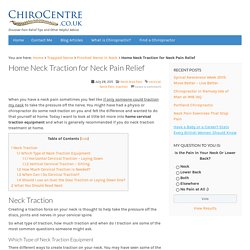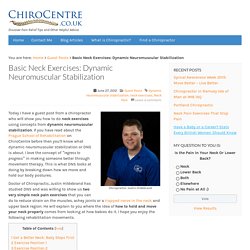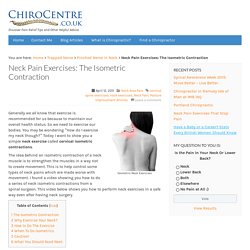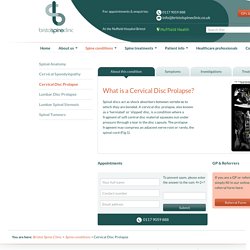

Home Neck Traction for Neck Pain Relief: ChiroCentre UK. When you have a neck pain sometimes you feel like if only someone could traction my neck to take the pressure off the nerve.

You might have had a physio or chiropractor do some neck traction on you and felt the difference and wanted to do that yourself at home. Today I want to look at little bit more into home cervical traction equipment and what is generally recommended if you do neck traction treatment at home. Neck Traction Creating a traction force on your neck is thought to help take the pressure off the discs, joints and nerves in your cervical spine. So what type of traction, how much traction and when do I traction are some of the most common questions someone might ask. Which Type of Neck Traction Equipment There different ways to create traction on your neck. Horizontal Cervical Traction ~ Laying Down If you have had neck (cervical) traction when being treated before you probably have had horizontal cervical traction.
Vertical Cervical Traction ~ Sitting Download (PDF, 104KB) Neck Pain Exercises: The Best Two Neck Workouts. When you have a sore neck it can be so frustrating not being to find good info or guidance on how to stop the pain.

There are loads of ways to treat a painful neck. Exercise is still one of the best treatment tools available. Our bodies were designed to move and move properly. Bad posture habits and poor movements patterns do contribute to the cause of the ache or pain your experiencing. Knowing how to move your neck to feel that relief you’ve been looking so hard for is what I want to show you today. Basic Neck Exercises: Dynamic Neuromuscular Stabilization : ChiroCentre UK. Today I have a guest post from a chiropractor who will show you how to do neck exercises using concepts from dynamic neuromuscular stabilization.

If you have read about the Prague School of Rehabilitation on ChiroCentre before then you’ll know what dynamic neuromuscular stabilization or DNS is about. I love the concept of “regress to progress” in making someone better through movement therapy. This is what DNS looks at doing by breaking down how we move and hold our body postures. Doctor of Chiropractic, Justin Hildebrand has studied DNS and was willing to show us two very simple neck pain exercises that you can do to reduce strain on the muscles, achey joints or a trapped nerve in the neck and upper back region. He will explain to you where the idea of how to hold and move your neck properly comes from looking at how babies do it.
Get a Better Neck: Baby Steps First by Dr Justin Hildebrand, DC. Neck Pain Exercises: The Isometric Contraction: ChiroCentre UK. Generally we all know that exercise is recommended for us because to maintain our overall health status.

So we need to exercise our bodies. You may be wondering “How do I exercise my neck though?” Today I want to show you a simple neck exercise called cervical isometric contractions. The idea behind an isometric contraction of a neck muscle is to strengthen the muscles in a way not to create movement. This is to help control some types of neck pains which are made worse with movement. Cervical Disc Prolapse. Most patients will improve with conservative treatment including reduced activity and pain medication.

Gentle neck traction physiotherapy my also help relieve the pain for short periods. These simple measures can lead to a full recovery in up to 80% of patients within 4 to 6 weeks. Forceful chiropractic or osteopathic spinal manipulation should be avoided as this has the potential to aggravate or damage the compressed nerve root or spinal cord. There are several situations where your doctor or spine therapist may recommend an appointment with a consultant spinal surgeon for further advice: Failure to improve after 4-6 weeks of conservative treatmentIntolerable, disabling or worsening painArm or hand muscle weaknessBladder or bowel problemsDifficulty with walking and poor balance Depending on the severity of the symptoms, the surgeon may advise a steroid nerve block or an operation. There are two main types of operation for a cervical disc prolapse. Arm Pain In Association With Neck Pain.
This pain is sometimes called brachalgia, a ‘pinched nerve’, or cervical radiculopathy, it is very similar to sciatic pain but affecting a nerve in the neck rather than the lumbar spine.

Irritation or compression of a nerve in the neck leads to some pain in the neck with more severe pain spreading down the arm. The pain can also be associated with tingling (parasthesia) and numbness in the arm and hand, and occasionally weakness in the arm The distribution of the pain and numbness in the arm is dependent upon the nerve root affected, the nerves on the right and left are numbered C1, C2, C3, C4, C5, C6, C7, C8 and T1.
The commonest nerves affected are C5-C7 The distribution of the pain and numbness/ tingling generally follows the pattern on the right. The muscles in the arm are also innervated by specific nerves and thus a C5 problem causes difficulty with deltoid, C6 with biceps, C7 with triceps and C8 / T1 with the muscles of the hand. Investigations Plain Xray Nerve Conduction Studies. Most Important Exercise to Help Pinched Nerve and Neck Pain / Dr. Mandell. Great Exercise for Neck Pain, Pinched Nerve, Dowagers Hump, Poor Posture / Dr Mandell. The Bible of Reasons & Exercises to Correct Lower Neck Pain (Pinched Nerve) / Dr Mandell.